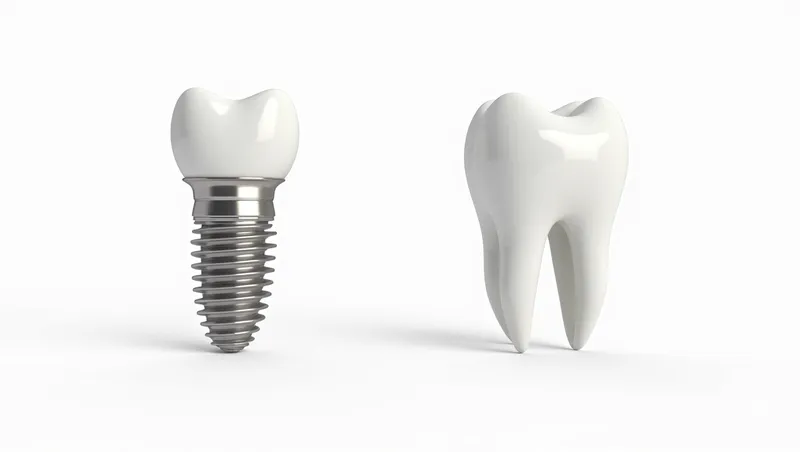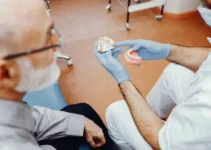Understanding the fundamental differences between dental implants and natural teeth is crucial for anyone considering dental restoration options. While both serve similar functions in terms of aesthetics and chewing ability, they have distinct characteristics in terms of structure, sensitivity, and maintenance requirements. Natural teeth have a periodontal ligament that provides sensory feedback and allows for minor movements, while dental implants are directly fused to the jawbone through osseointegration, offering stability but lacking the natural sensory mechanism.
What is a dental implant?
A dental implant is a sophisticated tooth replacement solution that serves as an artificial tooth root. Unlike traditional dental solutions, implants offer a permanent and stable foundation for replacement teeth. These biocompatible devices are typically made from medical-grade titanium, which has proven to be exceptionally compatible with human bone tissue and provides remarkable durability.

The revolutionary aspect of dental implants lies in their ability to mimic natural tooth structure through a process called osseointegration. During this biological process, the implant forms a direct structural and functional connection with the surrounding bone tissue, creating a stable foundation that can last a lifetime with proper care. This integration process typically takes between 3-6 months, during which the implant becomes firmly anchored in the jawbone. Modern dental implants have shown impressive success rates of up to 98% when properly placed by experienced professionals. They not only restore functionality but also help maintain jawbone density and prevent facial structure changes that often occur with tooth loss.
Components of a dental implant
The dental implant system consists of three main components, each serving a crucial role in creating a functional tooth replacement:
- The titanium post (implant body): Acts as the artificial root and integrates with the jawbone
- The abutment: Serves as a connector between the implant and the crown
- The crown: Provides the visible portion that resembles a natural tooth
The titanium post is the foundation of the entire system. Its surface is typically treated with special coatings or textures to enhance osseointegration and ensure optimal bone attachment. The abutment is precisely engineered to provide the perfect angle and support for the crown while ensuring a secure connection to the implant body.
The final component, the crown, is customized to match your natural teeth in both color and shape. It’s typically made from high-grade ceramic materials that offer both durability and aesthetic appeal.
How dental implants work
The success of dental implants relies heavily on the remarkable process of osseointegration. This biological phenomenon involves the direct structural and functional connection between living bone tissue and the surface of the load-bearing implant. The process begins immediately after implant placement, as specialized bone cells called osteoblasts begin to form new bone tissue around the implant surface.
During the healing period, the titanium implant develops a unique biological bond with the surrounding bone tissue. This integration creates a connection that’s actually stronger than the natural connection between teeth and bone, providing exceptional stability for the replacement tooth.
The implant’s functionality is further enhanced by its ability to transmit bite forces directly to the bone, similar to natural teeth. This mechanical stimulation helps maintain bone density and prevents the jaw deterioration that typically occurs with tooth loss. Research has shown that properly integrated implants can withstand forces of up to 200-400 pounds per square inch, matching or exceeding the capability of natural teeth.
If you’re interested in learning more about dental health and restoration options, we invite you to explore our other articles about advanced dental procedures and innovative treatments that can help maintain your oral health and enhance your smile.
What is a natural tooth?
A natural tooth is a remarkable biological structure that represents millions of years of evolutionary development. These highly specialized organs are essential for various functions including chewing, speaking, and maintaining facial structure. Natural teeth are composed of multiple layers of specialized tissues, each serving a specific purpose in oral health and function.
Unlike any artificial replacement, natural teeth possess a complex network of nerves, blood vessels, and specialized tissues that work together to maintain oral health. They have the unique ability to adapt to changes in pressure, temperature, and bite forces through their sophisticated sensory system, making them incredibly efficient tools for mastication and protection against harmful stimuli.
The preservation of natural teeth is always the primary goal in dentistry due to their irreplaceable characteristics. They provide superior bite force distribution, proprioception (position sense), and maintain optimal bone health through constant stimulation of the surrounding tissues.
Natural tooth anatomy
The crown of a natural tooth is covered by enamel, the hardest substance in the human body, which protects the underlying structures from wear and chemical attacks. This translucent layer is composed primarily of hydroxyapatite crystals, making it extremely resistant to daily mechanical stress.
Beneath the enamel lies the dentin, a slightly softer tissue that provides support to the enamel and contains microscopic tubules that communicate with the central pulp chamber. The dentin plays a crucial role in tooth sensitivity and acts as a protective barrier for the pulp.
- The pulp chamber contains blood vessels, nerves, and connective tissue
- Dentin continues to form throughout life as a protective mechanism
- Secondary and tertiary dentin formation helps protect against decay and wear
The innermost layer, the dental pulp, is often called the “living tissue” of the tooth. It contains blood vessels, nerves, and specialized cells called odontoblasts that continue to produce dentin throughout the tooth’s life, responding to various stimuli and maintaining tooth vitality.
Natural tooth connection to the jaw
The attachment of natural teeth to the jawbone is facilitated by the periodontal ligament (PDL), a complex network of collagen fibers that connects the root cementum to the surrounding alveolar bone. This specialized tissue provides crucial shock-absorbing properties and allows for slight movement of the tooth within its socket.
The PDL contains mechanoreceptors that provide vital feedback about pressure and position, enabling precise control during chewing and biting. This sophisticated sensory system helps prevent excessive force application and potential damage to the tooth structure.
- Periodontal ligament space measures approximately 0.2mm wide
- Contains specialized cells for bone and cementum maintenance
- Provides nutritional support to the surrounding tissues
The biological connection between tooth and bone through the PDL also maintains bone health through mechanotransduction, where mechanical forces are converted into biological signals. This process is essential for maintaining proper bone density and preventing bone loss in the jaw area.
Differences between dental implants and natural teeth
Understanding the distinctions between dental implants and natural teeth is crucial for patients considering tooth replacement options. While dental implants are designed to mimic natural teeth in both form and function, there are several fundamental differences that patients should be aware of. Modern implant technology has evolved significantly, offering a success rate of over 95% according to recent clinical studies.
The integration process between implants and natural teeth differs substantially. Natural teeth develop through a biological process, while dental implants require a surgical procedure and a period of osseointegration – the process where the implant fuses with the surrounding bone tissue. This healing period typically takes 3-6 months, depending on individual factors and the specific implant protocol used.
Both options serve the same primary purpose of maintaining oral function and aesthetics, but their biological and mechanical properties create distinct characteristics that influence their performance and longevity. Research indicates that properly maintained dental implants can last for decades, though their long-term success depends heavily on proper care and maintenance.
Structural differences
The most fundamental structural difference lies in the composition and attachment mechanism. Natural teeth consist of enamel, dentin, and pulp, connected to the jawbone through a periodontal ligament that provides shock absorption and sensory feedback. In contrast, dental implants are typically made of biocompatible titanium or zirconia and connect directly to the bone through osseointegration.
The attachment mechanisms create distinct characteristics:
- Natural teeth have periodontal ligaments that allow micro-movements
- Implants are rigidly fixed to the bone without any intermediate tissue
- Natural teeth can adapt to bite changes over time
- Implants maintain their fixed position permanently
Research has shown that the absence of a periodontal ligament in dental implants results in different biomechanical properties. While this might seem disadvantageous, modern implant designs have been optimized to distribute forces effectively, ensuring long-term stability and function.
Functional differences
The functional capabilities of dental implants and natural teeth show notable variations in terms of sensory feedback and adaptation. Natural teeth contain nerve endings that provide detailed sensory information about pressure, temperature, and position. Dental implants, while highly functional, lack this intrinsic sensory mechanism and rely on surrounding tissue for limited feedback.
Mobility patterns also differ significantly between the two. Natural teeth exhibit slight physiological mobility due to their periodontal ligament, allowing them to adjust to changing bite forces. Dental implants remain completely rigid, which can actually provide advantages in terms of stability but requires careful consideration during the treatment planning phase.
Temperature sensitivity is another key distinction. While natural teeth can detect temperature changes and potentially react painfully to extremes, dental implants do not transmit temperature sensations. This characteristic can be beneficial for patients who previously experienced sensitivity issues with their natural teeth.
Maintenance and care requirements
Maintaining dental implants requires specific care protocols that differ from natural teeth. While both need regular cleaning, the techniques and tools used may vary. Natural teeth benefit from traditional brushing and flossing, while implants might require special interdental brushes and water flossers for optimal cleaning around the implant-crown junction.
Professional maintenance schedules typically include:
- Regular dental check-ups every 4-6 months
- Professional cleaning with specialized instruments
- Periodic evaluation of implant stability and bone levels
- Assessment of surrounding soft tissue health
Long-term success of dental implants heavily depends on maintaining excellent oral hygiene and regular professional care. While natural teeth can sometimes recover from periods of poor oral hygiene, implants require consistent maintenance to prevent peri-implantitis, an inflammatory condition that can lead to implant failure if left untreated. If you found this comparison between dental implants and natural teeth informative, you might also be interested in exploring our articles about advanced implant techniques, bone grafting procedures, or the latest developments in dental implant technology. Understanding these differences is crucial for making informed decisions about your oral health care options.
Common questions about dental implants vs natural teeth
Understanding the differences between dental implants and natural teeth is crucial for making informed decisions about your oral health. Here are the most frequently asked questions about this topic.
What is the main difference between a dental implant and a natural tooth?
A natural tooth has a periodontal ligament that provides sensory function and allows minor movements, while a dental implant is directly fused to the jawbone (osseointegration) and lacks this sensory ability.
Do dental implants feel different from natural teeth?
Yes, dental implants feel slightly different because they don’t have nerve endings. However, most patients adapt quickly and find them comfortable for eating, speaking, and daily activities.
Are dental implants stronger than natural teeth?
Dental implants are more resistant to decay and can withstand stronger biting forces. However, natural teeth have better shock absorption and sensory feedback, making them more adaptable to varying pressures.
How long do dental implants last compared to natural teeth?
With proper care and maintenance, dental implants can last a lifetime, while natural teeth are susceptible to decay and various dental issues. However, the crown on the implant may need replacement every 10-15 years.
Can dental implants get cavities like natural teeth?
No, dental implants cannot develop cavities since they’re made of titanium and artificial materials. However, proper oral hygiene is still essential to prevent gum disease and maintain the surrounding tissues.




